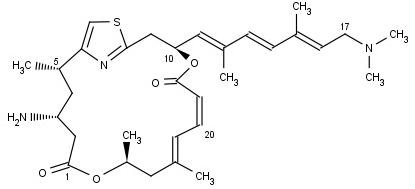|
Related Topics: |
|
|
|
Current News |
|
Chemistry A to Z |
|
About Internetchemistry |
Pateamine A |
|
Pateamine A (PatA), a natural product first isolated from marine sponges, has attracted considerable attention as a potential anti-cancer agent, and now a new activity has been found for it, which may reveal yet another anti-cancer mechanism. That’s the assessment of Daniel Romo, a Texas A&M chemistry professor, and his colleagues at Johns Hopkins University who are pioneers in research involving this novel marine natural product. Messenger RNA (mRNA), as its name indicates, copies messages from genes on DNA and uses these messages to produce proteins, and the human body functions well only with the right types and amount of proteins. So, what happens when mRNA gets damaged? Will the wrong proteins produced by the wrong messages carried by mRNA damage a person’s body? |
|
|
Don’t worry – it’s under surveillance, and PatA has been found to inhibit one such surveillance mechanism called NMD, Romo says. NMD stands for nonsense-mediated mRNA decay, a key mechanism in the cell to degrade damaged and not fully functional mRNA. NMD watches inside the body 24 hours a day, and whenever damaged mRNA is found, NMD attaches a “bad-mRNA” tag on it and summons an army to destroy it.
However, with cancer cells, inhibition of NMD is desirable. “We found that PatA and a simplified, easier to synthesize derivative of PatA called desmethyl,desamino-PatA (DMDAPatA) inhibit NMD,” the Texas A&M professor says. “This may contribute to the apoptosis (suicide) of tumor cells.” Romo and colleagues from Johns Hopkins University School of Medicine, University of Heidelberg and European Molecular Biology Laboratory published their recent findings in the Journal of Biological Chemistry.
Romo is no stranger to PatA. He began to work on its synthesis more than a decade ago. In 1998, the Texas A&M professor’s group achieved the first laboratory synthesis of PatA, and, in 2005, using a PatA conjugate, his collaborator, professor Jun O. Liu at Johns Hopkins, found that PatA inhibits the initiation phase of protein synthesis, which gives PatA the potential to fight cancer. “Tumor cells are more actively producing new proteins than normal cells, so tumor cells are hundreds if not thousands of times more vulnerable to DMDAPatA’s inhibition of protein synthesis, which makes DMDAPatA a good candidate as an anti-cancer agent,” he explains. “DMDAPatA is structurally simpler than PatA but exhibits similar activity in inhibiting NMD and protein synthesis,” Romo notes. “It has been patented by Texas A&M, evaluated by two pharmaceutical companies, and continues to be evaluated as a potential anti-cancer agent for both human and animal (pet) applications.” |
|
|
|

